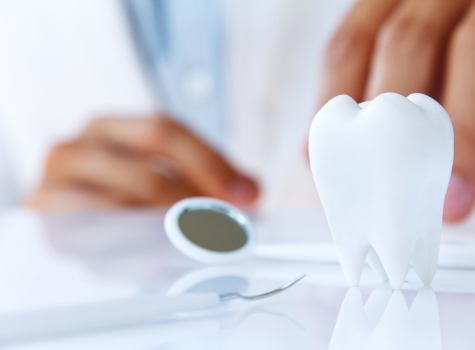Dental Checkups – Hoover, AL
Catch Dental Disease Before It Develops

If you want to keep your mouth healthy, oral hygiene is absolutely necessary. Long-term ailments, whether it’s gingivitis (the mild form of gum disease) or periodontitis (the more severe form), develop as a result of bacteria that forms plaque and eventually hardens on the teeth and gums. Without removal, it can lead to severe and even permanent damage to your oral structures. By maintaining a good at-home dental care routine and attending regular dental checkups in Hoover, AL, you can keep your mouth free of bacteria and stop inflammation, tooth decay, infection, and tooth loss.
Why Choose Moulton Dentistry of Hoover for Dental Checkups?
- Dentist Dedicates as Much Time as Possible to Patients
- We Run On Time – Minimal Waiting Required
- Intraoral Cameras and Digital X-Rays for More Efficient Diagnosis
Why You Should Always Get Regular Dental Checkups

Through regular dental checkups, we can not only confirm the effectiveness of your current methods of dental care but also suggest tips for your future care to help protect your smile and prevent potential complications, including gum disease and cavities. These visits also make it easier to catch problems earlier and fix them as soon as possible.
How Often Should You Get a Dental Exam?

We recommend that patients get a dental exam completed once every six months. Of course, we encourage you to consult with our team first so we can determine how often your mouth should be examined. For example, we may want you to visit more frequently if you perform habits that can negatively affect your oral health, including smoking. If tooth decay, as well as gum disease, are more likely as a result of your genetic disposition to oral bacteria, we may ask that you visit more often.
What to Expect During Your Dental Checkup

Our team makes sure to carefully and thoroughly clean your teeth during your dental checkup, removing external stains and tartar (calculus), which is more difficult to remove than normal plaque. Tartar removal requires a professional touch as well as advanced dental instruments. During your exam, we’ll also confirm the signs of tooth decay or gum disease. If needed, an X-ray will be performed so we can create a more detailed summary of your oral health and more effectively address problems. Dr. Moulton will ask about your current dental care methods, including whether or not you brush your teeth, floss or use toothpastes containing fluoride. This information will help us better demonstrate how proper dental care is performed and provide suggestions on how you can improve your oral care habits, ensuring optimal oral health.
Do You Need to Prepare for a Dental Exam?

Make sure to practice good dental care prior to your dental exam. This is done by brushing twice a day and flossing at least once a day, as recommended by Dr. Moulton. Please clean your teeth beforehand on the day of your appointment. It is more helpful to remove plaque before your visit so that our team can focus on the more difficult areas that you aren’t able to reach. Furthermore, having pertinent information on hand regarding your medical history, dental insurance coverage, and current dental care methods always make our job easier. We don’t want you to feel embarrassed about your current oral care habits; our team is never here to judge you. Instead, we’d much rather work with you by giving advice intended to improve your oral care habits! Once your exam is over, please be prepared to schedule a follow-up or checkup appointment.
How to Properly Brush Your Teeth

Our dental office recommends using a soft- or medium-bristled toothbrush. Angle the brush at 45 degrees, ideally where the teeth meet the gums, then gently move it in a circular motion. This should be done several times with small strokes, gently brushing the outside surfaces of your tooth enamel. Apply light pressure when brushing between teeth. Use less pressure if you start to feel discomfort.
After you’ve cleaned the outside surfaces, switch to the inside surfaces of your back teeth. Apply the same technique.
Hold the brush vertically to clean the inside surfaces of your upper and lower front teeth more easily. Use several back-and-forth motions over your tooth. Make sure to brush the surrounding gum tissue as gently as possible.
Clean the biting surfaces with short gentle strokes. Change the position of your brush as needed so you can reach all of your surfaces. Use your bathroom mirror to confirm that you’ve cleaned each surface. Once completed, vigorously wash your mouth out with water to remove any plaque that you loosened during your brushing.
Floss the Correct Way

In most cases, gum disease starts between teeth. Since your toothbrush cannot reach these areas, you’ll need to use dental floss to remove plaque. Flossing is the most effective way to remove plaque from the vertical surfaces of teeth. This is why we emphasize the importance of developing proper flossing technique. With these instructions, you’ll be better equipped to perform better oral care, just make sure to practice daily.
Begin by removing a piece of waxed floss, pulling about 18 inches worth. Wrap this floss around your middle finger of one hand as gently as possible. The rest should be wrapped around the middle finger of your other hand.
Hold the floss tightly between your thumb and forefinger to clean your upper teeth. Then, gently slide the floss between your teeth. Use a back and forth motion, rather than forcing the floss. Avoid snapping it into place as this can damage your enamel. Push the floss towards the gum line, then curve it so that it creates a C-shape against your tooth. Slide it into the space between your teeth and stop once you start to feel resistance. Carefully move the floss up and down onto the side of your tooth. Both sides of your tooth need to be cleaned, so keep this in mind once you move on to the next space. Floss all of your upper teeth and avoid cutting your gum tissue between your teeth. Once plaque collects on the floss, turn your finger so that it wraps around it, providing you with a clean section for additional teeth.
Cleaning bottom teeth starts by guiding floss using the forefingers of both of your hands. Make sure to clean the backside of the last tooth on both sides, including your upper and lower teeth.
Rinse your mouth out vigorously with water when you are done to remove loosened plaque and food particles. If your gums bleed or feel a little sore after your first week of flossing, do not be alarmed. If your gums do feel sore, try to use less force next time to avoid accidentally pinching your gums. Flossing daily and removing plaque will become easier and the bleeding and soreness should stop as you perform the habit daily.
Caring for Sensitive Teeth

Teeth can feel sensitive to hot and cold temperatures following your dental treatment, which is normal. While this feeling does not last very long, you’ll need to make sure that your mouth stays clean. An unclean mouth will only continue to experience sensitivity and could become severe if left untreated. Those who have particularly sensitive teeth should talk to their doctor. They’ll likely recommend a medicated toothpaste or mouth rinse designed for those with sensitive teeth.
Choosing Oral Hygiene Products

With so many oral care products on the market, it can become daunting to choose one that fits your needs. Below, we’ve included tips and suggestions for choosing dental care products that work for most of our patients.
To start, automatic or electric toothbrushes are generally safe and ideal for most patients. While oral irrigators help rinse your mouth out more thoroughly, they cannot remove plaque and therefore should not replace brushing or flossing. Always use them in tandem with brushing and flossing, not in place of them. We often get fantastic results from electric toothbrushes provided by Interplak and Rotadent.
If you find a toothbrush equipped with a rubber tip in the handle, it’s used to massage the gums after you’ve brushed. Tiny brushes, or interproximal toothbrushes, are used to clean areas between your teeth. Always discuss the use of these products with your doctor first as improper use can injure your gums.
If used in tandem with brushing and flossing, fluoride toothpastes and mouth rinses can dramatically reduce tooth decay, sometimes as high as 40 percent! However, we do not recommend that you provide these rinses to children under six years of age. If you have tartar above the gum line, tartar control toothpastes can offer great benefits. Just keep in mind that gum disease starts below the gum line, which means these toothpastes haven’t been proven to reduce the early stages of gum disease.
If you choose an anti-plaque rinse approved by the American Dental Association, they should contain agents that control the early signs of gum disease. Use these products to complement your brushing and flossing, not replace them.
